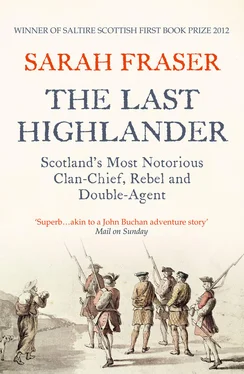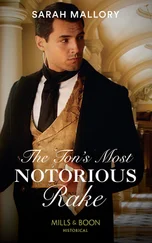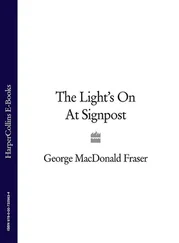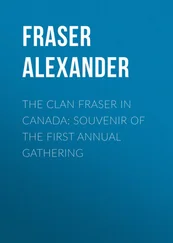He could have added that they cared less than they knew. They did not see the multi-layered and shifting array of words and images that entered Simon and his brothers’ minds. Simon’s clan homeland was so remote from the rest of Britain that southerners often made out their wills before venturing there. One traveller to the Highlands returned hugely relieved to get out. ‘I passed to English ground, and hope I may never go to such a country again. I thank God I never saw such another.’
It was traditional for the Master of Lovat (the eldest son), any potential heirs, and the principal gentlemen of Clan Fraser to attend Aberdeen University. Simon Fraser went there later than his peers, after a gap of a few years. The young man who arrived in Aberdeen in 1691 to study was about twenty years old, high-minded, intellectually curious, charming, extremely ambitious and proud. Six foot tall in his stockinged feet, he was bright-eyed with a wide, well-shaped mouth half-smiling above a strong, set jaw. A lace jabot foamed at his neck and a toffee-toned extravaganza of a wig tumbled down his back. Every inch of him proclaimed a self-conscious young Highland gentleman, and a Royalist.
In the 1690s half the population of Scotland lived north of the Highland line; Aberdeenshire was the most densely populated county. Aberdeen was divided into two parts: Old and New, the traditional and progressive incarnations of the town. The university had two colleges. Marischal College in New Aberdeen, founded in 1593, which was governed by a modern, Calvinist spirit; and King’s College in Old Aberdeen, where Simon came to study, as had his father, Thomas, his brother Alexander, and his mentor, the Reverend James, before him. King’s was founded in 1494 to the glory of James IV King of Scots, who died at Flodden Field. Roman Catholic until the mid-seventeenth century, King’s was established on a European Renaissance model, mimicking the universities at Paris and Bologna.
On the chapel tower rose one of the glories of King’s: an open lantern spire. ‘A double arch of crossed stone’, its two stone arms cross over. On top of the lantern spire ‘there standeth a royal crown … upon the top of the crown a stone globe; above it a double cross gilded; intimating as it were by such a bearing, that it is the King’s College’. Here the Crown of earthly power was supported and raised on top of the House of God. Finally, a double cross perched like a gull on the summit of the globe. No one could fail to read the message: at King’s the power of Monarchy, Bishops, Lords and the Lord intertwined. Divine right led to global domination.
As if to sober up the Royalists, God had smitten the crown on the spire in the previous generation, and it ‘was overthrown … by a furious tempest’. The Calvinists at Marischal College cheerfully mocked the Divine pretensions of the King’s College Stuart affiliation after the disaster, but Royalists recalled it was ‘quickly afterwards restored’ and ‘in a better forme’.
Simon Fraser lived in its shadow for five years. As a young man of his times he was steeped in this sort of apprehension of the immanence and intervention of the Divine in human life. He had already known four monarchs, despite his young age: Charles II ruled at his birth, followed by the short reign of Charles’s brother, James II, before James had fled the thrones three years ago, refusing to renounce his Roman Catholicism and the rights of his Roman Catholic son and heir. By 1691, the solidly Protestant William III and Mary II co-ruled England, Scotland and Ireland. Like Cromwell before them, they maintained an experienced standing army in North Britain, quartered throughout Scotland with no regard for the local capacity to feed, water or house all these extra men.
Haars, the sea mists breathed out of the North Sea when the cold sea air meets the warm air off the land, haunted the mud streets around the King’s College buildings, clinging to clothes, wigs and livestock, and drifting against the windows, some glassless, some with tiny opaque panes in the rooms where Simon came to sit, take down his ‘dictats and notts’, and learn. Tallow candles wavered against the gloom of lecture rooms. The gesture of a fire hissed. Eyes, struggling in the half-light to take down etiolated Latin quotations, were further harassed by the smoke. Simon roomed in cramped chambers in a building abutting the chapel.
The curriculum at Aberdeen offered a mix of academic studies, physical and martial training. It continued the education Simon had received at home from the Reverend James. The Reverend’s nephew, Regent (Lecturer) George Fraser, was allocated to Simon as tutor for the duration of his degree. The timetable ran from the beginning of November to the end of June. The ‘conveniendums’ (times of convening to learn) were from seven to nine in the morning. After a break for breakfast, Simon worked from ten in the morning until midday. If it was ‘a play day’ he only worked again from five to six in the evening. If not, he sat from four to six o’clock. Before, after and in between all of this were prayers – in the Common School or at the dining table.
Recalling his university years, Simon described the timetable as gruelling. ‘I was the youth of this Age that applied himself most to College Learning,’ he said with pride. He followed the ordinary degree course in philosophy, yet he disparaged it. ‘I read ten hours every day,’ he said. ‘That four years’ study never signified a sixpence to me except to help me to chatter on some such foolish subject as Ens rationis.’ At other times he conceded that ‘the Philosophy class’ strengthened ‘discourse in arguing, which in my opinion is the most material thing which can be learned at Colleges now’. He could not possibly imagine in 1691 how much he would owe to that ability in later life.
The curriculum gave him more than training in rhetoric and disputation. Many decades ahead Simon would tell a friend: ‘I always observed since I came to know anything in the world, that an active man with a small understanding will finish business and succeed better than an indolent, lazy man of the brightest sense and the most solid judgement.’ His conclusion reflected his reading list at Aberdeen where they studied the recorded writings of Cicero, who pronounced ‘the active life is of the highest merit’. Machiavelli, also on the curriculum, agreed with the Roman: ‘An active man can achieve anything if he repudiates half-measures,’ he suggested. This was the intellectual discourse of Simon’s formative years: Cicero, Virgil, Aristotle, Machiavelli, Erasmus, Petrarch, Pufendorf and Grotius. These men taught Simon the power of human action to direct affairs, and jurisprudence. A strong man could be an agent of change, progress and power thanks to his own efforts – if he was wholehearted, ruthless and prepared. Simon’s life was not merely the effect of God’s, or godly government’s, design. If he needed a rationale for his relentless activity as an adult, Aberdeen and raw necessity supplied it.
After the day’s work, the ‘Hebdomadars’ – a sort of saintly university security force – received the keys of the college gates at nine at night. They would go to check on every room to ‘observe the absents’, or ‘inquire if prayer and reading a part of the Scripture be gone about’. Examination of sacred lessons, and testing students through ‘public disputes … in the Common School’ on Saturday mornings kept Simon busy, honed his debating skills. Sundays meant mortification and endless opportunities, or obligations, for copious prayers.
All his life – as Episcopalian, or Roman Catholic – Simon enjoyed theological dispute. But he kept ‘charity for all mankind’ on this matter, he said. Though passionate about politics, society and culture, religious intensity bored most King’s College men. Typically, Simon’s friends were lovers of the old High Church type of Protestantism. Called ‘Episcopalianism’ in Scotland, it was roughly equivalent to Anglicanism in England. They preferred to believe in bishops appointed by the King, and both appointed by God. The idea of a clan chief corresponded with the mystique of a divinely sanctioned ruler.
Читать дальше












